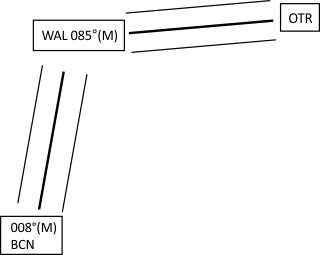The Navigation Computer: Two-drift Winds
The 3-drift wind would only be necessary for particular applications (for example, bush flying and maritime flying, as previously discussed). However, it would be possible to use 2-drift winds when flying on airways in the UK in an aircraft which is not equipped with more than airways minimum navaids (i.e. no RNAV, GPS, INS or FMS). In this case, the 2 headings need to be at nearly right angles to each other, and certainly in excess of 70°. Consider the situation below:

The planned track from Brecon to Wallasey is 008°(M) along airway A25, then from Wallasey to Ottringham on a track of 085°(M) along airway B1. The pilot homes into Wallasey by applying his planned drift to the VOR track. If his drift is wrong, the VOR radial will change. He gets back onto the correct centre line, then modifies his drift depending on how the radial changed. After a short period of trial and error he will establish the correct drift to hold the radial.
He then arrives at Wallasey and turns onto the planned heading to hold the outbound track along B1. Again, if the planned drift was not correct, there will another short series of trials and corrections until he finds the heading that holds the VOR radial consistently. He now has drifts for 2 headings and can use the Navigation Computer to find the wind point from the cross-cut of the drifts on the appropriate headings. The only problem with a 2-drift wind is that there is no confirmatory third cut to give some confidence in the other two, but it should be possible to assess the drift reasonably accurately when flying along a VOR centre line.
Next: Wind Components
© 2022 terms of use privacy policy